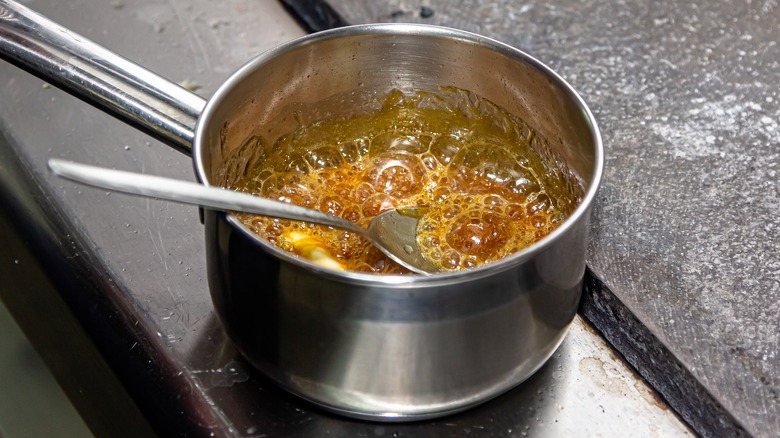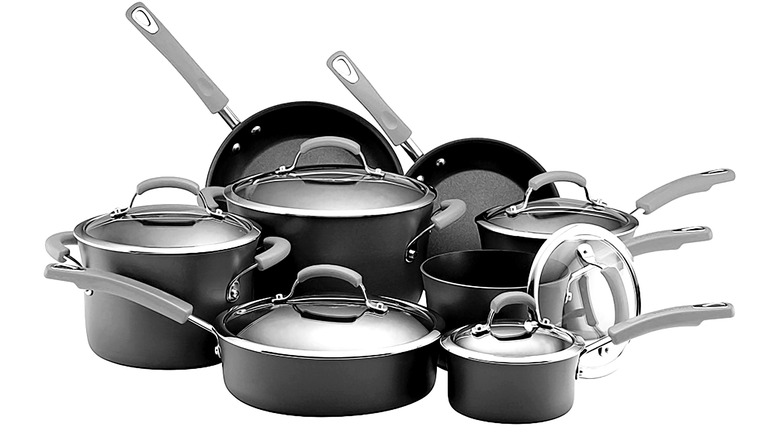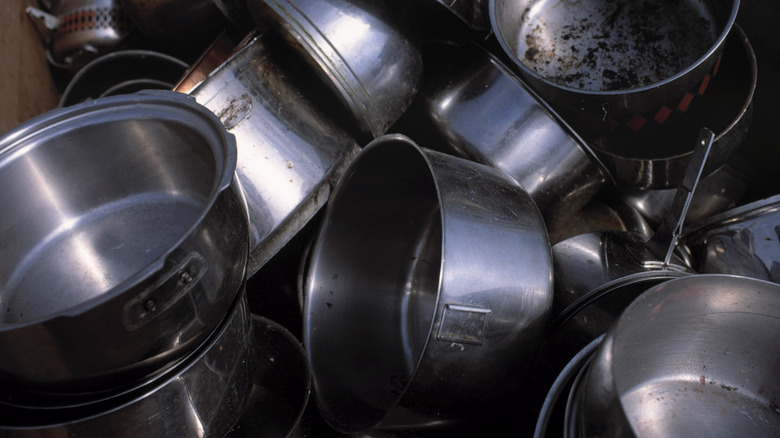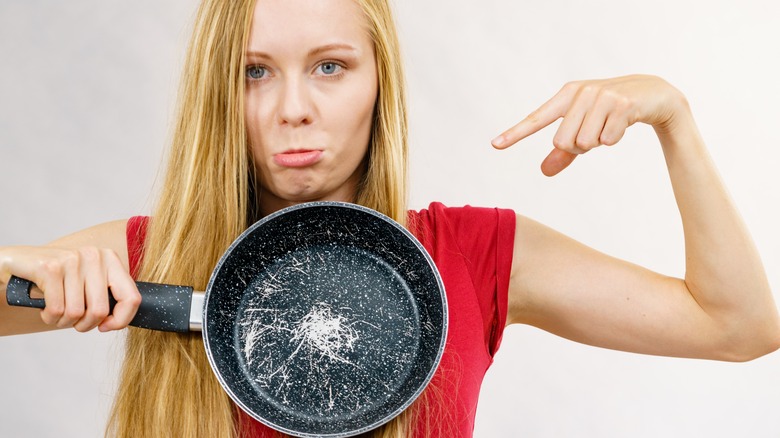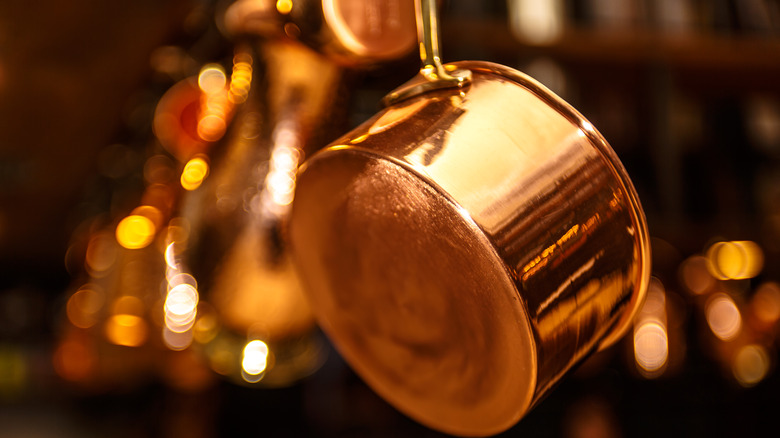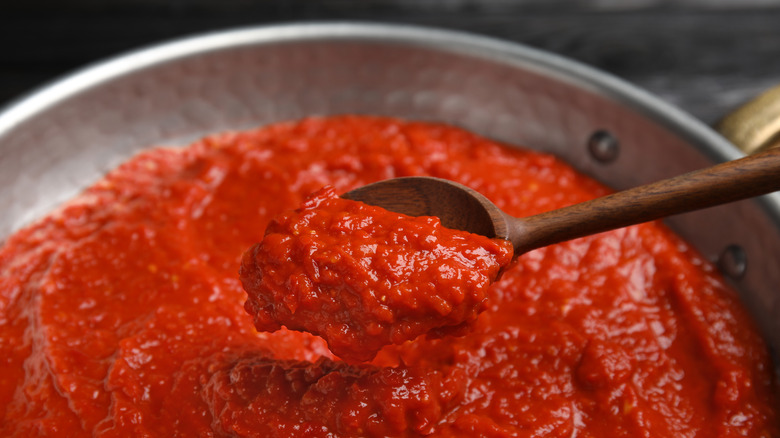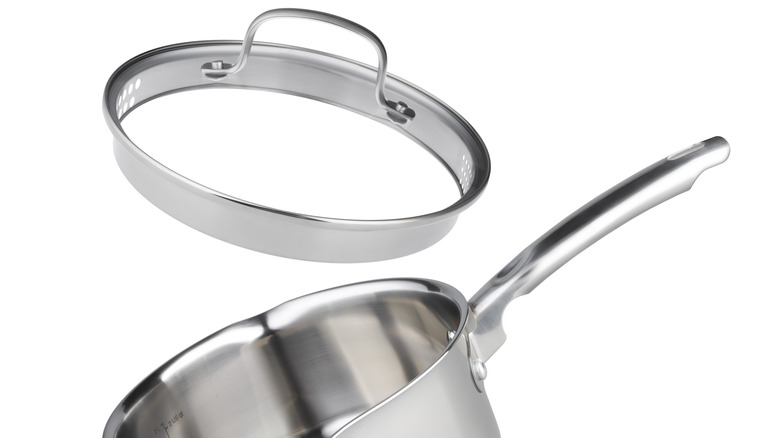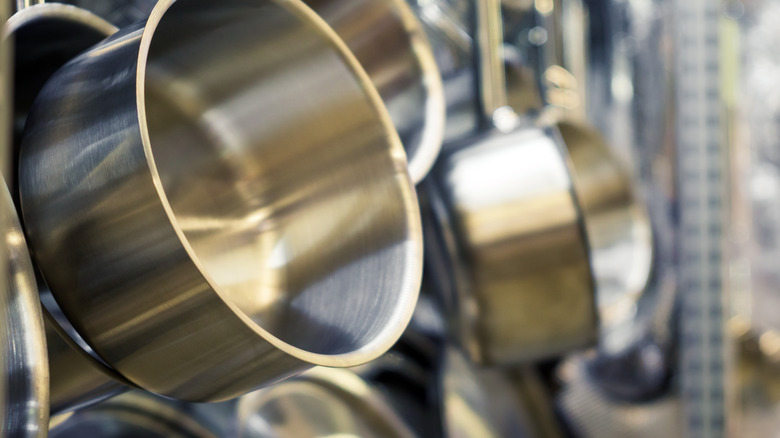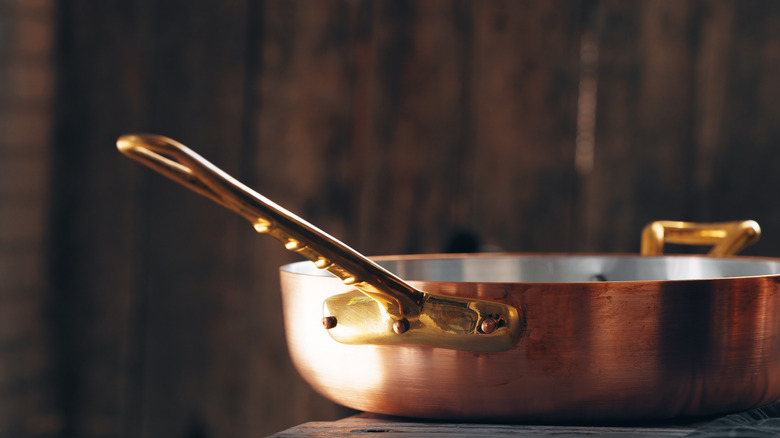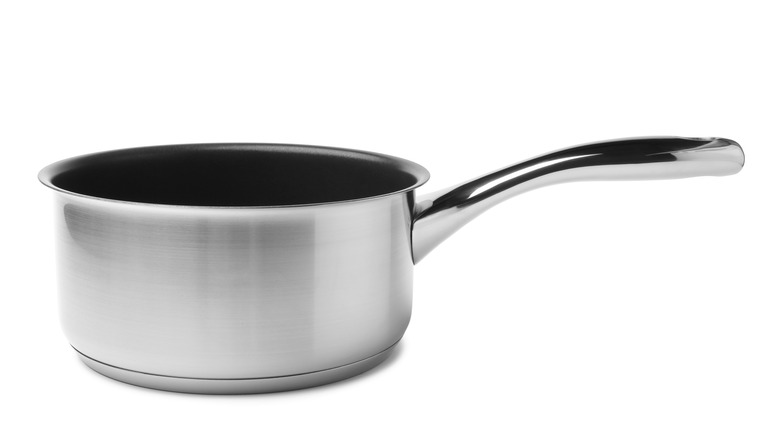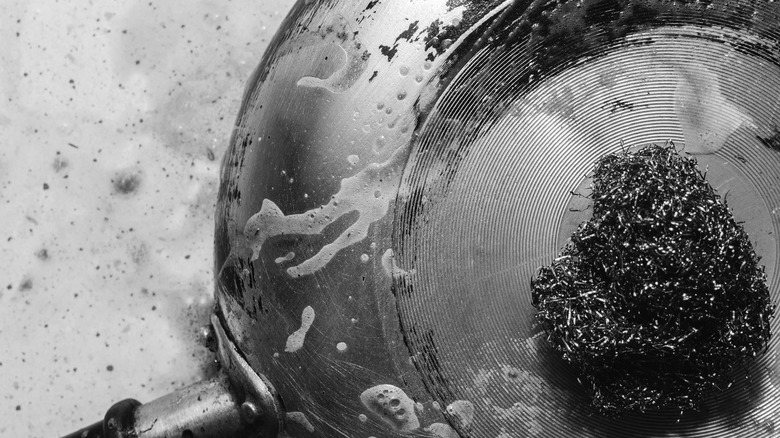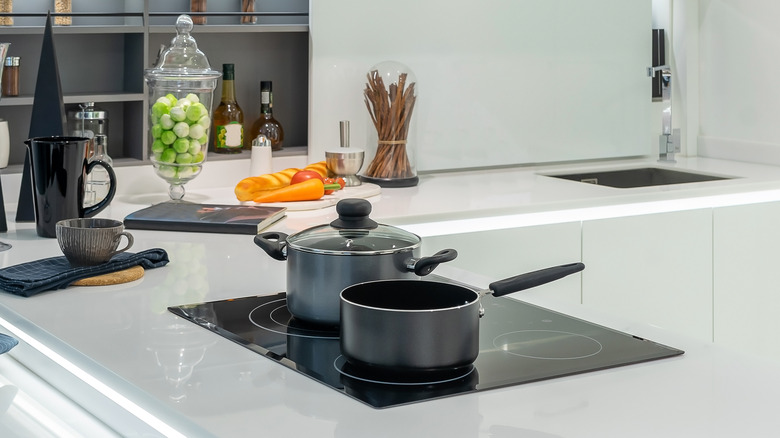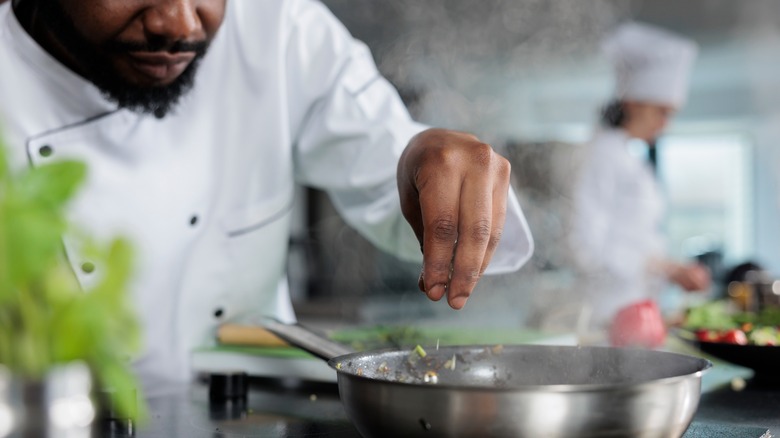Things You Should Know Before Buying A Saucepan
Do you remember the very first meal you ever cooked? Whatever it was, it must have felt great to accomplish such a feat. According to Dr. Nicola Williams Ph.D. (via News Medical), cooking has a positive effect on your mood and mental health, whether you are a kitchen novice who just happens to walk into the kitchen for an easy mid-week freezer meal or a proud home cook following in the footsteps of your grandmother's recipe tradition.
If that doesn't inspire you to pick up a pan, nothing will. But all kidding aside, if you want to achieve mental bliss, you're going to need some tools. Therefore, we'll introduce a very important piece of cookware. You'll learn why a saucepan is a cornerstone of any kitchen, how to determine its most important parts, and how to choose the best pan to match your cooking style.
Needless to say, if cooking can have a positive effect on your mind, imagine pairing that with quality cookware. If you are at least a little bit serious about cooking, you'll find your "zen" here. Promise.
The difference between a saucepan and other cookware
You may have heard of this little kitchen workhorse before, but it's easier to get confused than you think. A saucepan has a deep, round shape and straight sides, and typically comes with a lid and a handle. Taking away a handle for a moment, you may be wondering if it's just another pot. Well, as MasterClass explains, the main difference lies in its primary function. As the name suggests, a saucepan is usually the best cookware for stirring sauces. Whether you're preparing a cream cheese alfredo sauce for your pasta or want to create a rich balsamic reduction, a saucepan will help you do that effortlessly while the handle gives you the control you need when whisking. It isn't all a saucepan can do, however. It's also handy when you want to blanch your greens or poach your eggs in the morning.
Pots, on the other hand, are typically deeper, can hold more liquid, and allow for longer cooking times, so they're an ideal choice for making tomato sauce, soups, or stews. Another similar cookware you may come across is a sauté pan. At first glance, you'll notice that it has a much wider base than a saucepan. A sauté pan is perfect for searing a steak, deglazing stock, or preparing a side of sautéed vegetables.
Do not waste money on cookware sets
It could have been a wedding gift or, perhaps, one day you watched an episode of ”Chef's Table” and decided to take your cooking skills to the next level. Whatever the reason, you ended up getting a new, shiny cookware set. Now be honest with yourself, is there a piece in this set (or a few), you'd simply hide in the darkest corner of your cupboard, for months, perhaps even years? There's a great chance you don't even know if it's there anymore.
In an interview with Consumer Reports, Lisa McManus, executive testing and tasting editor at "America's Test Kitchen," suggests only spending money on five reliable pieces of cookware. A saucepan tops this list as a must-have addition to any home or professional kitchen. Kristen Miglore, founding editor and creative director of Food 52's Genius Recipes, names a 3- to 4-quart saucepan as a good starting point. If you're not sure, the rule of thumb would be to go a size bigger, as cooking less food in a larger saucepan works perfectly well. WebstaurantStore recommends paying attention to the width of your pan, as it gives a different quality to the cooking: With a narrow bottom, the food retains more moisture, while a wider pan heats the food more rapidly.
Not all cookware materials are safe
There isn't a topic in the cookware world that stirs up more debate than the use of per- and polyfluoroalkyl substances (PFAS) in nonstick coatings (per National Institute of Environmental Health Sciences), including the famous Teflon. A series of lawsuits against DuPont (via Water Finance and Management), the company responsible for concealing the truth about the toxicity of these chemicals, contributed to the Environmental Protection Agency (EPA) tightening regulations on a large number of these chemicals and eventually phasing them out between 2000 and 2002, per the EPA. Particular attention has been paid to PFOS, which has been officially linked to the development of cancer, as published in 2016 in Regulatory Toxicology and Pharmacology.
Why is it still relevant? Well, the use of PFAS-related substances in the manufacture of cookware is still common. A new generation of PFASs, such as GenX and PFBS, as well as PTFE, which is considered safer, are still widely used. The problem with this is that there haven't been enough tests conducted to prove that they're equally harmful. We can only add that buying cookware with PFAS, which is currently still closely monitored, according to the U.S. Consumer Product Safety Commission, might be somewhat risky.
Even though high-quality, non-stick cookware is considered safe, it's only safe until you scratch it. Healthline explains that a scratched nonstick coating can still release plastic polymers into your food and recommends looking for alternatives like ceramic or cast iron.
Invest in a quality saucepan
Increasing access to goods and services beyond the fundamental necessities could be seen as a major step towards a common good. However, as with any commodity, buying cookware can easily lead us into the same consumerism trap. There's an old saying ”buy cheap, pay twice." If we look at this closer we may find the latter is true.
A Consumer Research Report conducted by PLMA states that ”the majority of people tend to replace their old cookware every 1-2 years.” Considering that some quality brands like Calphalon offer a lifetime warranty on their products, it doesn't take long to do the math to see that two years to replace a pan is a false economy.
Buying quality cookware not only means long-term savings but also great results in the kitchen. Of course, not everyone will be able to spend as much as $399.00 for a top-shelf copper pan from All-Clad. Luckily for us, there are other brands out there, such as Misen, offering top-performance cookware at a reasonable price. You can tell they have confidence in their products when you see a lifetime warranty tag next to them. No more excuses.
Acidic foods may react to the metal of your saucepan
It's no secret that cookware made of aluminum, copper, iron, and steel is more resistant to corrosion, although the Council of Europe describes some of these metals as reactive to acidic and alkaline foods. But how dangerous is it when used in cookware? Take aluminum, for example, which numerous sources cite as one of the most reactive and toxic metals. Despite its bad reputation, it's considered safe when coated, according to the Council of Europe.
Another highly reactive metal, copper, also doesn't pose a serious health risk when coated. In fact, a deficiency of copper is considered a greater health risk than its ingestion. So as long as you don't use your mom's old copper pots, you're in the clear. A study published in 2013 in the Journal of Agricultural and Food Chemistry goes into more detail, noting that while stainless steel does leach chromium and nickel into foods, it usually only does so when acidic foods are cooked for an extended period of time and the amounts released are considered to pose minimal to no health risk.
The takeaway from this: Reactive metals need to be coated with another layer of non-reactive metal, so be sure to buy properly labeled and regulated cookware from trusted manufacturers. Although the potential risks of using such cookware are considered low, the effects on children and people with certain conditions, such as chronic renal failure or sensitivity to chromium and nickel, should be considered when purchasing.
Buy a quality lid now to save money later
As Suriya Jayanti, an expert on energy policy in Eastern Europe, warns us of an even greater energy crisis (per Time magazine), energy-saving tips that previously seemed insignificant will now surely take root in our minds. Putting a lid on the cooking pot is a great way to cut down on your energy bill. A 2019 study from Iowa State University (via ResearchGate) concluded that cooking with a lid can increase energy efficiency by up to 12%. Not so bad when cooking is something we do every day.
When buying a saucepan, it is rather common for the lid to be included, but that's not always the case, especially with highly customizable professional cookware. The "Guide to Cookware and Bakeware," published by The Cookware & Bakeware Alliance, also recommends cooking with a lid to preserve the nutrients in the food by releasing the steam back into the liquids. Another good reason to get a lid.
The most important thing you should look for when buying a saucepan is the material of the lid. Glass lids are great for seeing food as it cooks, but they tend to be heavier and can break if not handled carefully. Metal lids, on the other hand, can never be broken, but if they're made of aluminum, for example, they can easily warp when exposed to high heat. Stainless steel is usually recommended as the more practical choice.
Clad metal cookware is the ultimate all-in-one choice
As we all know, the basis for cooking is essentially a relationship between heat, time, and your cookware. The rest is all about finding that sweet spot. Some cookware materials help with this better than others. Looking at data from a study published in 2017 in the Journal of Information, Knowledge and Research in Mechanical Engineering, we find that aluminum and copper are the two best conductors of heat. But that comes with a problem — both metals react easily with food. To solve the problem, we need to cover it with another layer of non-reactive metal, such as stainless steel. The result is a pan with the best thermal properties.
The technology of layering different metals is called Bottom Clad, Two-ply, Three-ply, and Five-ply, according to The Cookware and Bakeware Alliance guide. The designations are pretty self-explanatory, with the number simply indicating the number of layers used, while Bottom Clad indicates that additional layers are only attached to the bottom of the pan or pot. Depending on your budget, most clad designs consist of either an aluminum or copper layer sandwiched between additional layers of stainless steel.
So to round this up, material selection is the single most important decision when choosing your saucepan because it will determine how well it will perform. If you're not a professional chef or seasoned cook who needs special precision, go with clad cookware — you won't regret it.
Functional cookware does not have to be ugly
Some of us just want to get it over with when we cook. But if you like to spend hours in your state-of-the-art kitchen hosting lavish dinner parties for your friends, you certainly have an eye for the design of your cookware. We can only add, if it works as well as it looks, it is sure to spark a conversation around the table.
So what makes beautiful cookware? Copper- and stainless steel-clad pans are both visually and functionally stunning. It's hard not to be impressed by their precise polish and clean lines. The combination of these two metals will retain their gleaming luster for many years, dish after dish.
Longevity, however, isn't the only quality that defines functional beauty. Caraway, for example, has launched a chemical-free cookware line that is truly non-stick. It's super easy to clean and comes in a wide range gorgeous colors, making it incredibly fun to use. We know you may not be all about sprucing up your countertop, but with a sturdy cast iron pan available in a variety of colors, like Le Creuset's, everyone has a chance to shine in the kitchen.
It is easy to overlook the importance of a good handle
A good handle can mean the difference between a perfectly cooked sauce and a hospital stay. Quite literally, if you're not careful when using a pan with a handle that gets hot, painful disasters are bound to happen. The best way to avoid this is an obvious one: Purchase a saucepan with a cool touch handle. Also, make sure the handle is made of non-conductive metal like stainless steel and is long enough to distribute heat. The handle shouldn't be too long, however, as this can lead to poor handling and another disaster.
If you are buying a saucepan with a plastic handle, you should also check if it's suitable for the oven. These plastics can usually withstand a maximum of 400 degrees Fahrenheit before they begin to melt. Finally, check how the handle is attached to the pan. Rivets are considered the industry standard for high-end cookware, so they're sometimes poorly copied on cheaper products to mimic the high-end look and feel. There should be absolutely no gap between a rivet and the pan.
Poor maintenance is not covered by a lifetime warranty
Every now and then we all get lazy or lose focus. But if you're willing to invest in a cooking pot that will last a lifetime, then be willing to nurture it. Yes, nurture it for a lifetime. Sounds dull maybe, but you'll find that quality cookware manufacturers provide all the necessary motivation you need and will void your warranty if you're not careful.
It's simple: If you're not sure whether or not you should wash your cookware by hand, all you have to do is follow a few guidelines in the user manual. For instance, All-Clad clearly tells you not to leave your pan on a burner empty, avoid overheating, and never exceed 600 degrees Fahrenheit when using cookware in the oven. You're also told never to pour cold water over a hot pan or the metal can become permanently warped.
If you follow the instructions given, your cookware should remain in pristine condition for generations to come. However, you shouldn't expect it to stay the same color forever, as prolonged use can cause discoloration. Finally, ensure you're using the recommended cleaner on your cookware.
Using induction cookware on a gas stove and vice versa
Induction is emerging as the new standard for stovetops and is expected to double its market value by 2032, according to Future Market Insights. Despite that, there are still many cookware products being produced that aren't induction compatible by design, meaning they are made of non-ferrous materials, like copper, aluminum, zinc, and glass ceramic, per CNET. If you're a fan of electric cooktops, be sure to check the cookware manufacturer's instructions for each product. They're clearly marked with a special symbol for induction cooktops.
But what if you've chosen a nice copper saucepan and you have an induction stove? For this reason, Mauviel has developed a special steel plate that can be used with its exclusive copper range. You can also find many other steel plate alternatives online. So far, this is the only easily accessible way to use your induction non-compatible pans with induction technology.
Things look much better if we have an induction pan that we want to use on a gas stove. Most induction-compatible cookware is made of stainless steel plates, which are usually suitable for all heat sources. So that's not a problem.
Expert recommendations on choosing the best saucepan
There are plenty of saucepans to choose from, but we want the best, right? While we can all pretty much agree that quality and durability matter the most, we'd like to give you a few more tips from industry experts and chefs.
Abby Mallett, editor and writer for Joy the Baker, told Saveur that she likes to evaluate the brand's reputation to see how it stands up over time. According to Mallett, it's a good idea not to rush into buying a nice-looking pan from a brand you've never heard of, no matter the price. Gordon Ramsey, on the other hand, praised the versatility of cookware when asked about his recent partnership with HexClad. The unique combination of stainless steel and a non-stick coating gives HexClad cookware incredible functionality. If you must have everything in a single saucepan, this is a good way to go.
As you probably figured, it takes some research to find a perfect piece of cookware. So take your time and don't forget to weigh your budget first; the rest should now be a breeze.
